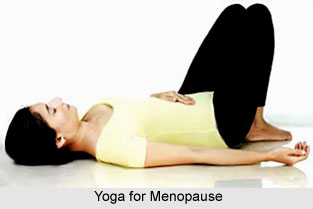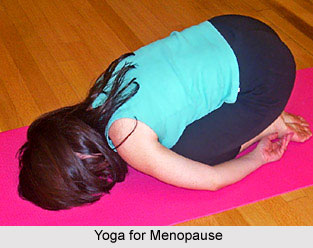Menopause is a part of every woman`s life that comes with various types of mental and physical changes. A series of Yoga asanas for Menopause greatly contribute in decreasing the severity of such health problems.
 Menopause is the stage when the menstrual period permanently stops. This stage usually occurs between the age of 40 and 60 associated with hormonal, physical and psychological changes. These changes can occur gradually or abruptly. This period can start as early as the age of 30 and last until as late as the age of 60. It can also occur when the ovaries are removed surgically or have stopped functioning due to some disorder. Menopause is not an illness but a natural biological process, though the risk for heart disease and osteoporosis rises after Menopause.
Menopause is the stage when the menstrual period permanently stops. This stage usually occurs between the age of 40 and 60 associated with hormonal, physical and psychological changes. These changes can occur gradually or abruptly. This period can start as early as the age of 30 and last until as late as the age of 60. It can also occur when the ovaries are removed surgically or have stopped functioning due to some disorder. Menopause is not an illness but a natural biological process, though the risk for heart disease and osteoporosis rises after Menopause.
Symptoms of Menopause include irregular menstruation, changes in sexual desire and appearance, hot flashes, vaginal dryness, sleep disturbances, urinary problems, mood changes, palpitations and backaches. It is not necessary that all women experience these symptoms, some are not even aware of any other changes in their body. Estrogen and progesterone level plays a vital part in Menopause. In this stage, the ovaries make less estrogen and progesterone. Estrogen is the female hormone that plays a major role in shaping your body and in preparing it for Pregnancy. When the body produces less of such hormones, the parts of the body that depends on estrogen keep them healthy shall react and this often causes the discomfort in some Women.
Menopause is divided into two stages, namely the Premenopause and Postmenopause. Premenopause is the time when the person begins to experience the signs and symptoms though she is still ovulating. A woman can experience uneven rising and falling of the hormone level that often cause her to feel hot flashes and variations in her menstruation. Postmenopausal stage is when she is about 12 months past the last period and her ovaries no longer produce estrogen and progesterone, nor release any egg.
Menopause does not actually require medical treatment since it is a biological process. The menopause treatments actually center on relieving the symptoms of menopause and in preventing any chronic condition that may occur during the postmenopausal years such as heart disease and osteoporosis. Exercising, proper diet, not smoking, and reduction of stress are effective ways to make Menopause more bearable and can also assist in preventing any chronic ailments that can occur in the postmenopausal years. Women who regularly practice yoga have a different and more positive experience. Not only do Hatha yoga postures and breathing practices balance the endocrine system, they also serve to calm down mood and adjust attitude.
During menopause, many experienced practitioners discover that their students are more open to exploring the spiritual aspects of yoga than the physical ones. The practitioners of Yoga after Menopause feel a deep pleasure in the peace and feeling of unity with the universe that they witness during their practice. Yoga postures successfully relieve hot flashes, night sweats and other symptoms. For centuries the classic inverted postures such as `Headstand` and `Shoulderstand`, as well as various relaxing forward bends and restorative postures, have been appreciated for their cooling and calming effects.
Regular yoga practice, as well as other regular exercise, such as, cycling or walking can help to alleviate the symptoms of Menopause. Yoga eventually eases mood swings and depression. Joint mobility increases rapidly with the focused attention and gentle stretching of yoga postures. Yoga postures, yoga breathing, and focused meditation tone and soothe the sympathetic nervous system and its regular practice alleviates anxiety.
There is a particular sequence of poses to stimulate the ovaries and pituitary gland to produce more hormones. This series has a claming, soothing, quieting effect on the nervous system and, if practiced regularly, these Yoga asanas provide a good foundation on which to build a yoga practice that will help maintain a woman`s well-being during her menopausal years and so on.
The sequence that can be performed while menopause is as follows -
•Standing forward and bending with the bottom against a wall
•Dog Pose, hanging from a strap if available or with the head supported
•Supported Lying Down Bound-Angle Pose
•Supported Legs-Up-the-Wall Pose
•Supported Bridge pose, lying back on props like bolsters or blankets
•Supported Child`s Pose
•Lying Down Bent-Knee Twist
•Supported Deep Relaxation Pose
 The experienced yoga practitioner often practices Headstand, either with the head on the floor or practiced between two chairs, and Shoulderstand, after the Standing Forward Bend and Downward Facing Dog Pose. If the person has a truly flexible body, she can bend forward in seated position without applying strain. Kapalabhati is a breathing technique used specifically for cleansing during menopause. If the woman has a lot of mucus in the air passages or feel tension and blockages in the chest it is often helpful to breathe quickly. Amongst the standing poses, the best ones include the Mountain Pose (Tadasana) that promotes the experience of stillness, strength, relaxed power, and immovable stability associated with mountains. Hands to Feet (Pada Hastasana) provide same benefits as the Forward Bend that restores elasticity to the spine, and stretches the ligaments of the legs, especially the hamstrings.
The experienced yoga practitioner often practices Headstand, either with the head on the floor or practiced between two chairs, and Shoulderstand, after the Standing Forward Bend and Downward Facing Dog Pose. If the person has a truly flexible body, she can bend forward in seated position without applying strain. Kapalabhati is a breathing technique used specifically for cleansing during menopause. If the woman has a lot of mucus in the air passages or feel tension and blockages in the chest it is often helpful to breathe quickly. Amongst the standing poses, the best ones include the Mountain Pose (Tadasana) that promotes the experience of stillness, strength, relaxed power, and immovable stability associated with mountains. Hands to Feet (Pada Hastasana) provide same benefits as the Forward Bend that restores elasticity to the spine, and stretches the ligaments of the legs, especially the hamstrings.
The Warrior Pose stretches and strengthens the arms and legs, thus increasing stamina, improving balance and concentration, and can also relieve backaches. If the woman is suffering from diarrhea, high blood pressure or neck problems, she should take extra caution practicing this pose. Standing Spread Leg Forward Fold strengthens inner, back legs and also the spine. People with lower back problems should avoid doing the full forward bend. For beginners, it is advisable to use props like a folding chair to support the forearms. Tadasana is very helpful in case of Menopause. This Tree Pose helps strengthen the thighs, calves, ankles and back. It also increases the flexibility of the hips and groin. The balance and concentration can also be improved with constant practice.
The standing side stretch pose helps the Menopause women with its two lines of energy radiating outward from the center. This is a simple Yoga Posture with a wonderful stretch in which one line of energy reaches upward from the belly and outward through the arm, and one line moves downward through the legs. Padmasana is also recommended, since this classic seated posture strengthens the ankles and knees, enhances concentration, and improves flexibility of the legs. Bhujangasana improves spinal flexibility and strengthens the muscles in the arms and back. Balasana is a gentle way of stretching the shoulders, hips, thighs, ankles, and back muscles and is a relaxation posture which is done to normalise the circulation after performing the Headstand. Paschimothanasana is meant to relax the body and mind, stretch the hamstrings, shoulders, and spine, relieve stress, and improve the posture and concentration by practicing the Seated Forward Bend. Sage Twist Yoga Pose or Marichyasana benefits the abdominal organs and spine. Pavanamuktasana is especially beneficial in case of Menopause since it activates the digestive organs and helps to lessen gastric problems.
Yoga during Menopause aims at complete relaxation of body and mind. There are three parts to proper relaxation - physical, mental and spiritual relaxation. The above mentioned asanas calm the body and mind, and makes the person feel refreshed after doing the asanas and the pranayamas.




















